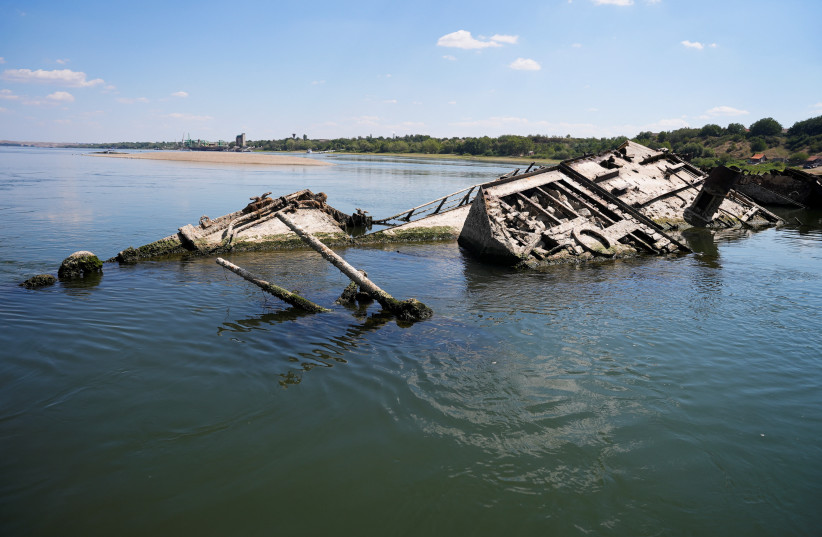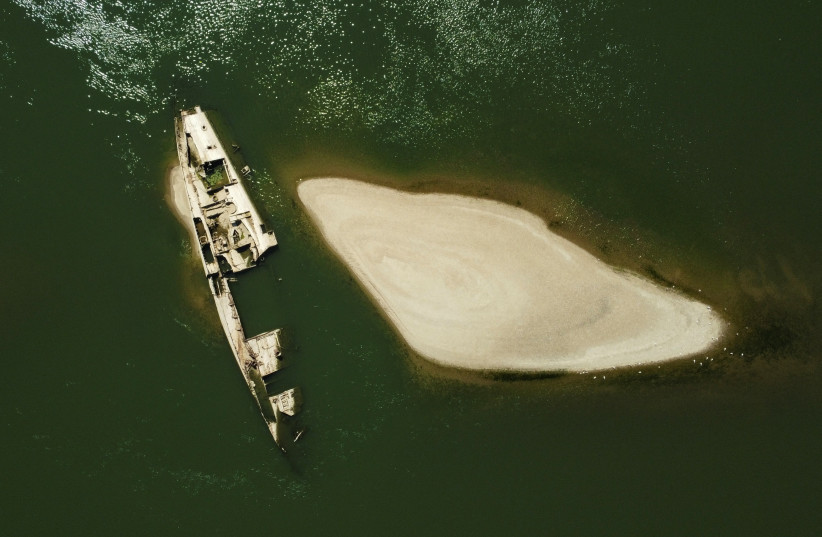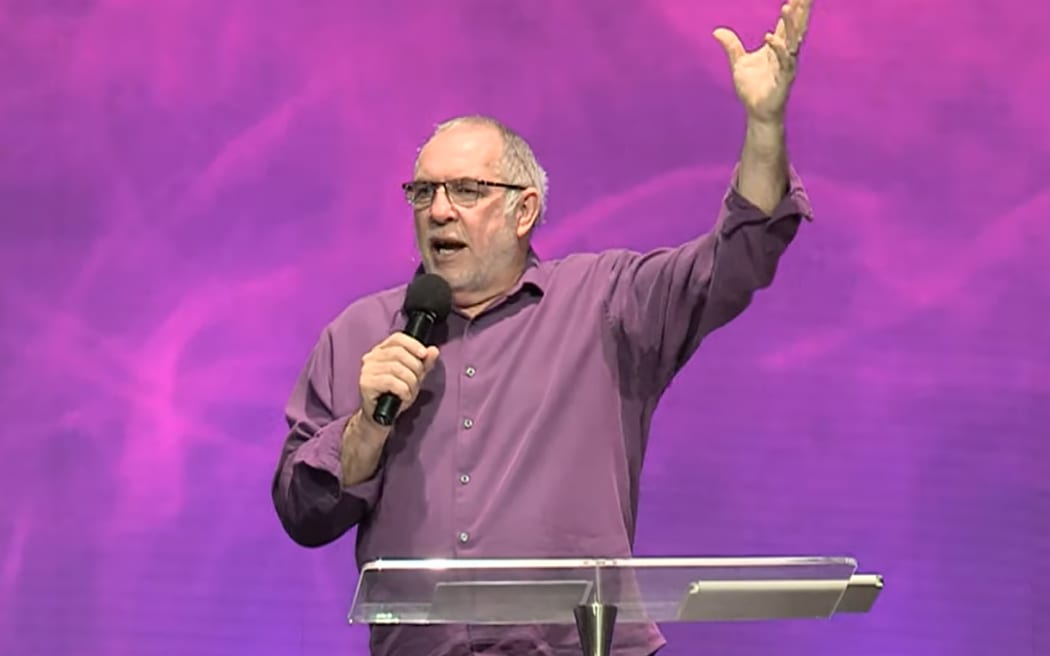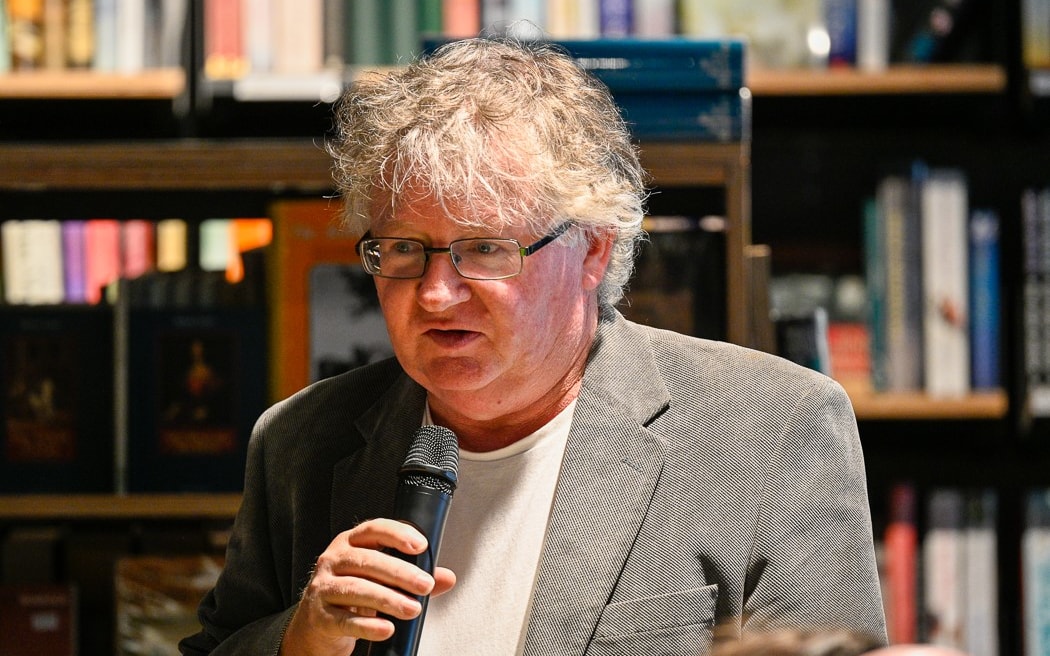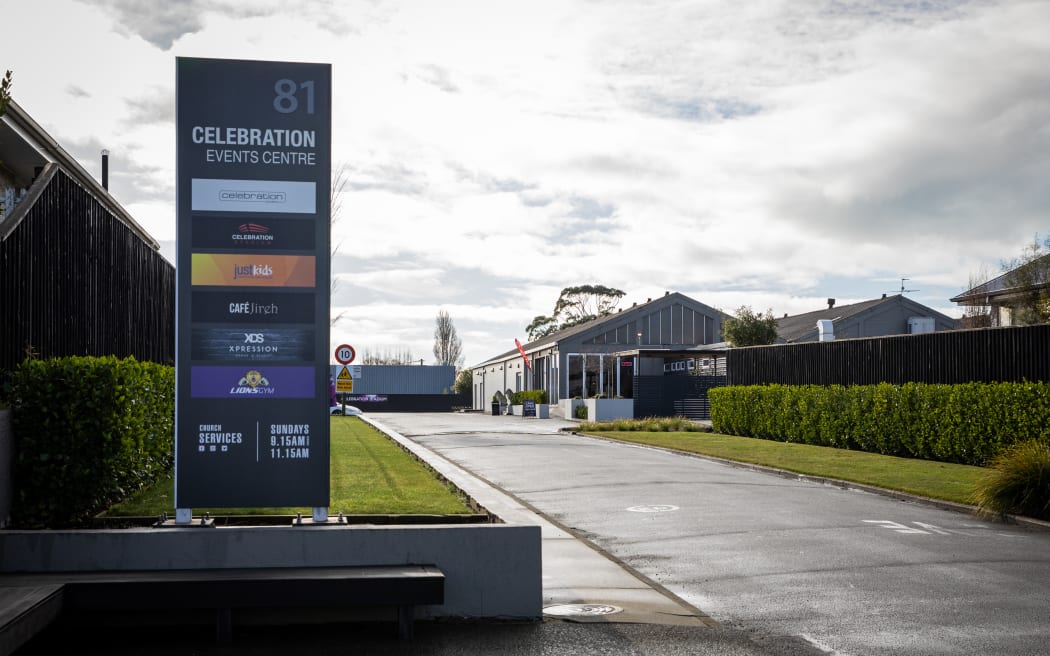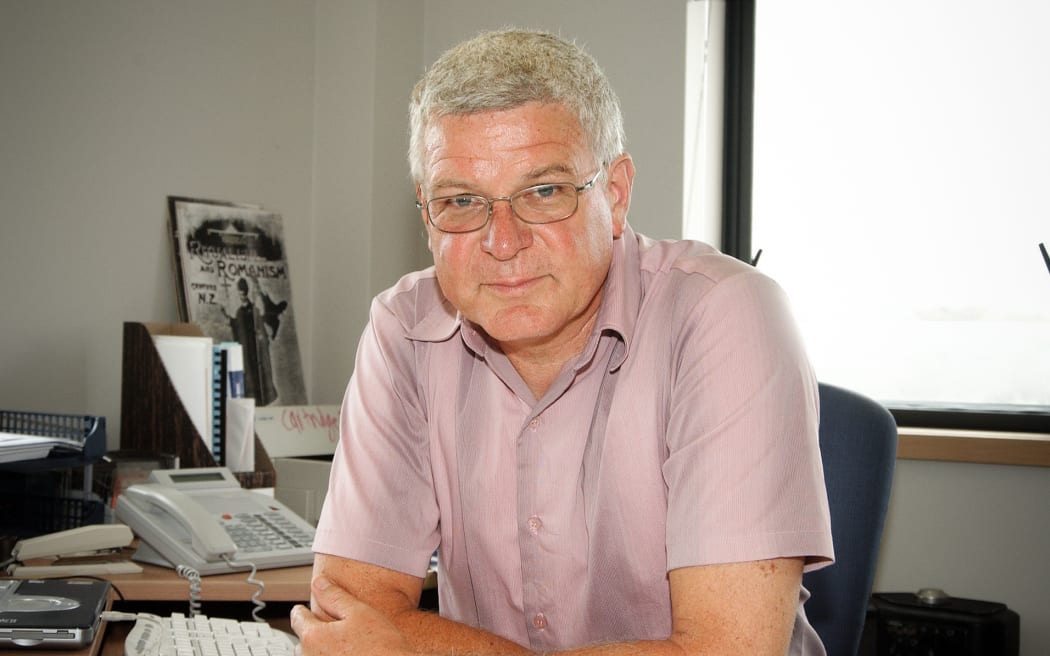Spirits of children buried at boarding schools provoke reckoning in Oklahoma and beyond

Rachel Mowatt, a special project manager for the Cheyenne and Arapaho Tribes, peers in July 2022 through a mural painted by Navajo-Euchee artist Steven Grounds on a wall of the now-closed Concho Indian Boarding School near El Reno, Oklahoma, which closed in 1983. Mowatt, of the Comanche and Delaware Nations, gave ICT a tour of the school ground, which was one of more than 75 Indigenous boarding schools operated in Oklahoma. (Photo by Mary Annette Pember/ICT)
WARNING: This story has disturbing details about residential and boarding schools. If you are feeling triggered, here is a resource list for trauma responses from the National Native American Boarding School Healing Coalition in the US. The National Indian Residential School Crisis Hotline in Canada can be reached at 1-866-925-4419.
MARY ANNETTE PEMBER
AUG 18, 2022
AUG 18, 2022
ICT
EL RENO, Oklahoma — The remains of the Concho Indian Boarding School have an aura of a long-past apocalypse that mysteriously snuffed out an ancient civilization.
Outlines of sidewalks and streets are barely visible through the densely wooded forest floor, and an old pedestrian bridge with rusty railings crosses a stream that leads to the abandoned site along the North Canadian River.
Built in 1903, the school served children from the Cheyenne and Arapaho tribes whose lands are centered in the town of El Reno in central Oklahoma.
Many of them never went home.
“They tell us that’s where the children are buried,” said Rachel Mowatt, a special project manager for the Cheyenne and Arapaho Tribes, pursing her lips, Native-style, in a gesture toward a small hill.
“Sometimes we hear the voices of children playing there.”
The tree-covered hill sits about a quarter mile away from the old school. Located near the wide fields of cut grass that surround the tribe’s administration buildings, it stands alone like a tiny, wild island.
“We’re instructed not to disturb that area,” said Mowatt, of the Comanche and Delaware tribes, who took ICT on a tour of the site in July.
EL RENO, Oklahoma — The remains of the Concho Indian Boarding School have an aura of a long-past apocalypse that mysteriously snuffed out an ancient civilization.
Outlines of sidewalks and streets are barely visible through the densely wooded forest floor, and an old pedestrian bridge with rusty railings crosses a stream that leads to the abandoned site along the North Canadian River.
Built in 1903, the school served children from the Cheyenne and Arapaho tribes whose lands are centered in the town of El Reno in central Oklahoma.
Many of them never went home.
“They tell us that’s where the children are buried,” said Rachel Mowatt, a special project manager for the Cheyenne and Arapaho Tribes, pursing her lips, Native-style, in a gesture toward a small hill.
“Sometimes we hear the voices of children playing there.”
The tree-covered hill sits about a quarter mile away from the old school. Located near the wide fields of cut grass that surround the tribe’s administration buildings, it stands alone like a tiny, wild island.
“We’re instructed not to disturb that area,” said Mowatt, of the Comanche and Delaware tribes, who took ICT on a tour of the site in July.

Rachel Mowatt, special project manager for the Cheyenne and Arapaho Tribes, tours the grounds of the old Concho Indian Boarding School in July 2022, including the remnants of an old bridge built in the early 1900s. The school, in El Reno, Oklahoma, was built in the 1903 and closed in 1983. It was one of more than 75 Indian boarding schools that operated in Oklahoma.
(Photo by Mary Annette Pember/ICT)
Although unmarked, the little hill commands attention. According to traditional Cheyenne and Arapaho beliefs, spirits of the dead require certain rights and ceremonies in order to be put to rest properly.
“No one ever performed traditional burial rights for these children; they deserve that today,” said Gordon Yellowman, director of the Cheyenne and Arapaho Tribes’ language and culture program.
“Not all of the schools had formal cemeteries but they all had some place where they buried their dead,” he said.
Oklahoma — which had more Indigenous boarding schools than any other state — stands as a microcosm for the U.S., where more than 400 Indian boarding schools once dotted the country.
Some of the 76 Indian boarding schools in Oklahoma operated for 10 years or less, closing in the late 19th or early 20th centuries. Most were originally founded by Christian missionaries and were later taken over by the federal government.
Indeed, the spirits of generations of children, many unnamed, are buried on the grounds of Oklahoma’s boarding schools, lost and endlessly traveling the earth in search of rest, Yellowman said.
It is a ghostly history that continues to haunt the U.S., calling out for recognition and reckoning.
Although unmarked, the little hill commands attention. According to traditional Cheyenne and Arapaho beliefs, spirits of the dead require certain rights and ceremonies in order to be put to rest properly.
“No one ever performed traditional burial rights for these children; they deserve that today,” said Gordon Yellowman, director of the Cheyenne and Arapaho Tribes’ language and culture program.
“Not all of the schools had formal cemeteries but they all had some place where they buried their dead,” he said.
Oklahoma — which had more Indigenous boarding schools than any other state — stands as a microcosm for the U.S., where more than 400 Indian boarding schools once dotted the country.
Some of the 76 Indian boarding schools in Oklahoma operated for 10 years or less, closing in the late 19th or early 20th centuries. Most were originally founded by Christian missionaries and were later taken over by the federal government.
Indeed, the spirits of generations of children, many unnamed, are buried on the grounds of Oklahoma’s boarding schools, lost and endlessly traveling the earth in search of rest, Yellowman said.
It is a ghostly history that continues to haunt the U.S., calling out for recognition and reckoning.
Life at Concho
Walking through the dense underbrush was slow going in the oppressive July heat, and the sound of insects thrummed loudly in a place that seemed nearly wholly subsumed by nature.
But Concho Indian Boarding School is not part of an ancient civilization. There are people alive today who attended the school, people who still hold memories of their lives there.
It was not so long ago that Native children of the 39 tribes that were moved to Oklahoma by the federal government with the enactment of the 1830 Indian Relocation Act were coerced into attending boarding schools.

Erma Jean Brown, 89, Cheyenne, graduated in 1951 from the old Concho Indian Boarding School in El Reno, Oklahoma. She said her experience was mixed but she was determined to make something of herself.
(Photo by Mary Annette Pember/ICT)
Erma Jean Brown of the Arapaho tribe graduated from the Concho school in 1951. She is now 89 years old and lives in Clinton, Oklahoma, about 50 miles west of the school.
“I’d say it was 50 percent good and 50 percent not-so-good,” Brown said, in describing her years at Concho.
At age 6, she was dropped off at the school by her grandmother. She remained there, off and on, for 12 years until she graduated.
“There were over 200 kids there and I didn’t know a single one; kids cried when their parents dropped them off but the parents didn’t come back,” Brown said.
She recalled her friend Edith, a pretty girl, who was raped by the school’s baker.
Brown encouraged Edith to report the assault. “They (school administrators) said she just made it up; there was a lot of cruelty there. That’s the honest-to-God truth,” she said.
“They just talked awful to you there. You didn’t get a feeling of love or caring. It was just cold.”
But as bad as it was, Concho was better than home where her mother’s drinking and revolving door of predatory boyfriends made life impossible.
“As I got older, I decided it was better to stay there but I thought, ‘I’m going to get out of here and do something with my life,’” Brown said.
A gym teacher at the school recognized Brown’s athleticism and encouraged her to compete in sports, which improved her confidence.
After Concho, Brown earned training as a drug and alcohol counselor, later working at Chemawa School in Oregon.
“I just loved the kids there and I think they loved me, too, because I treated them like humans,” she said.
Demanding acknowledgement
By the second half of the 20th century, Indian boarding schools had become ingrained, for better or worse, in the Native experience in the U.S.
In later years, the schools began placing less emphasis on destroying Native culture and assimilating students into mainstream America and more on supporting them where they were.
But a vestige of the inhumanity underlying the original destructive blueprint guiding boarding school policies lingers on, even for those who value their days at contemporary schools.
Erma Jean Brown of the Arapaho tribe graduated from the Concho school in 1951. She is now 89 years old and lives in Clinton, Oklahoma, about 50 miles west of the school.
“I’d say it was 50 percent good and 50 percent not-so-good,” Brown said, in describing her years at Concho.
At age 6, she was dropped off at the school by her grandmother. She remained there, off and on, for 12 years until she graduated.
“There were over 200 kids there and I didn’t know a single one; kids cried when their parents dropped them off but the parents didn’t come back,” Brown said.
She recalled her friend Edith, a pretty girl, who was raped by the school’s baker.
Brown encouraged Edith to report the assault. “They (school administrators) said she just made it up; there was a lot of cruelty there. That’s the honest-to-God truth,” she said.
“They just talked awful to you there. You didn’t get a feeling of love or caring. It was just cold.”
But as bad as it was, Concho was better than home where her mother’s drinking and revolving door of predatory boyfriends made life impossible.
“As I got older, I decided it was better to stay there but I thought, ‘I’m going to get out of here and do something with my life,’” Brown said.
A gym teacher at the school recognized Brown’s athleticism and encouraged her to compete in sports, which improved her confidence.
After Concho, Brown earned training as a drug and alcohol counselor, later working at Chemawa School in Oregon.
“I just loved the kids there and I think they loved me, too, because I treated them like humans,” she said.
Demanding acknowledgement
By the second half of the 20th century, Indian boarding schools had become ingrained, for better or worse, in the Native experience in the U.S.
In later years, the schools began placing less emphasis on destroying Native culture and assimilating students into mainstream America and more on supporting them where they were.
But a vestige of the inhumanity underlying the original destructive blueprint guiding boarding school policies lingers on, even for those who value their days at contemporary schools.

This undated historical photo shows the pedestrian bridge at the old Concho Indian Boarding School in El Reno, Oklahoma. A version of the bridge remained in July 2022.(Photo via Cheyenne and Arapaho Tribes)
For Mowatt, who graduated as valedictorian from Riverside Indian School in Anadarko, Oklahoma, in 1997, the experience was transformative.
It was at Riverside that she connected with her culture and gained a sense of community among other Native students.
“I wasn’t brought up in my culture,” she said. “Riverside opened doors to my Native identity.”
Even in such a positive environment, however, Mowatt was compelled to explore the grounds of the school, in search of something she couldn’t name.
Mowatt recalled an incident when she was walking behind the school’s gym building. A little boy appeared out of nowhere, running past her and a group of friends.
“We didn’t recognize him,” she said. “He was wearing leggings and had long hair, unlike the other boys at the school. He ran into our dorm building.”
Entering the dorm, she asked the matron if she’d seen the little boy; she hadn’t. All the children were accounted for.
“I believe he was a spirit,” Mowatt said. “It haunts me to know he was running for his life from the school.”
A new Concho school was built in 1968; its buildings are located about a quarter-mile from the school’s original site.
The rebuilt school was described as “a new exemplary Indian school” in a 1968 Bureau of Indian Affairs press release. In addition to preparing students for “a productive and self-sustaining life in American society,” the school was intended to support the role Native culture can play in providing students with a sense of “personal identification and belonging.”
The new Concho school, however, closed in 1983, due to a decrease in enrollment and federal funding.
The buildings from that era remain. The old campus – its dorms and classrooms – stands in the middle of large fields of grass, strangely isolated from nearby tribal buildings.
The original construction included the use of asbestos, so the campus is officially off-limits to the public until it can be safely razed, Mowatt said.
In 2014, Steven Grounds, an artist of the Navajo and Yuchee tribes, painted murals on the school’s decaying walls.

Murals on the rear side of the abandoned Concho Indian Boarding School in El Reno, Oklahoma, were painted by Steven Grounds of the Navajo and Euchee tribes.
(Photo by Mary Annette Pember/ICT)
The work is a series of huge portraits, some depicting famous Indigenous people such as Chief Black Kettle and Suzan Shown Harjo, both citizens of the Northern Cheyenne tribe.
Other portrayals are unknown, but all share a poignant quality, at once elegiac and celebratory.
Bold and unapologetic, the images seem to demand acknowledgement.
The work is a series of huge portraits, some depicting famous Indigenous people such as Chief Black Kettle and Suzan Shown Harjo, both citizens of the Northern Cheyenne tribe.
Other portrayals are unknown, but all share a poignant quality, at once elegiac and celebratory.
Bold and unapologetic, the images seem to demand acknowledgement.
A reckoning
So far, efforts to commemorate and reconcile Oklahoma’s boarding school past have been scattered, Yellowman said.
In 2021, the Catholic Diocese of Tulsa and Eastern Oklahoma launched the Oklahoma Native Schools project. Catholic entities operated 11 of the Indian boarding schools in the state from 1880 to 1965. The Diocese, according to its website, is working to create a report that “seeks to understand the history of Catholic Indian boarding schools in Oklahoma.”
Bryan Rindfleisch, associate professor of history at Marquette University, a Catholic school in Milwaukee, is conducting research into the Diocese’s archives kept in the university’s special collection.
At the former site of the Chilocco Indian School in Newkirk, Oklahoma, the Chilocco National Alumni Association has maintained the school’s cemetery since the late 1990s in efforts to honor students who died there.
Jim and Charmain Baker, former students at Chilocco, told Enid News that they have found dozens of graves dating between 1884 and 1937 at the school through research and use of ground-penetrating radar. The Chilocco school closed in 1980.
In an interview with ICT, Max Bear, the tribal historic preservation officer for the Cheyenne Arapaho Tribes, said that the tribes purchased a ground-penetrating radar unit in 2018 in order to search for graves at several boarding school locations in the region near the tribe’s headquarters in El Reno.
The pandemic, however, stalled plans for staff training on the machine. Bear hopes to get started on finding and identifying graves again soon.
Yellowman would like to see denominations that operated schools create an educational fund for tribes.
“Reparations are needed; this would be something Native people could use as a tangible resource,” he said.
Yellowman also envisions a traditional ceremony for the children who died at the schools.
“All of these decisions about reparations and ceremonies will have to be made collectively by the tribes,” he said.
As of now, Yellowman said, “Those children’s spirits are lost; they don’t know where to go.”

BY MARY ANNETTE PEMBER
a citizen of the Red Cliff Ojibwe tribe, is a national correspondent for ICT.











